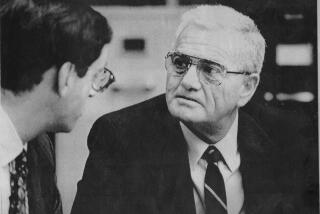In search of Ben Franklin’s books
- Share via
PHILADELPHIA — When it comes to literary mysteries, the death of Benjamin Franklin’s library is not exactly a whodunit.
Scholars already know the collection was killed by his grandson, William Temple Franklin, who inherited most of the books and sold them for cash.
The real crime, historians say, is that there’s no surviving inventory of the 4,276 volumes -- a list that could provide valuable insight into Franklin’s life.
That will change in coming months when the Library Company of Philadelphia and American Philosophical Society publish a catalog of titles that make up nearly half of Franklin’s lost collection. The volumes range from books on science and medicine to manuals on the mechanics of printing and the making of apple cider, not to mention classics such as “Don Quixote” and “The Odyssey.”
It will be the most complete list ever published, helping to solve a puzzle that dates back more than 200 years.
“Next to his own writings, this is the most important source of information about him,” said librarian James Green. “There are discoveries to be made here.”
Franklin’s collection was one of the largest private libraries in America at the time and took up the entire second floor of an addition he built on his Philadelphia home, Green said. When Franklin died in 1790, the books were scattered among a number of institutions and relatives. Most were bequeathed to Temple Franklin.
The grandson, though, had no interest in the library and “looked on it as an asset to exploit,” Green said. By 1794, Temple Franklin had sold his volumes to a man who ended up going bankrupt four years later.
The books then ended up in the hands of bookseller Nicholas Dufief, who sold them off between 1801 and 1803 to buyers including then-President Thomas Jefferson. A deal fell through for the Library of Congress to acquire the remainder of the collection. And though Dufief had published catalogs of the titles, those lists were lost as well.
Yet one important part of Franklin’s collection did survive: The “shelfmark.”
The penciled notation inside his books consisted of the letter “C” followed by numbers and then “N” followed by more numbers. It was first noticed around 1935 by members of the American Philosophical Society, a Philadelphia-based group founded by Franklin that had bought some of his volumes from Dufief.
But was the shelfmark made by Dufief or Franklin?
Enter Edwin Wolf, a librarian at the Library Company. The organization, started by Franklin and other bibliophiles in 1731, is now an independent research institution documenting American history through the 19th century.
Years of research culminated in 1956 when Wolf discovered the shelfmark in volumes Franklin bequeathed directly to the library and the Philosophical Society -- books that had not been handled by Dufief. The marks weren’t always easy to find; some were hidden under bookplates placed by subsequent owners and some had been papered over when the volumes were rebound.
Further confirmation came in 1962 from a descendant of Benjamin Franklin Bache -- another grandson of Franklin who had inherited a smaller part of the library.
Among Bache’s papers was an inventory of titles with the header “List of books for B.F. Bache” in Temple Franklin’s handwriting. It was the list of volumes bequeathed to Bache by the Founding Father.
The volumes were listed by “Case” and “Number,” leading Wolf to conclude the shelfmark referred to the location of the books on Franklin’s shelves at home. The “C” stood for “case” and indicated on which shelf the book belonged, while the “N” stood for number, referring to the position of the book on the shelf.
By the time he died in 1991, Wolf had deduced about 3,000 titles contained in about a thousand volumes, or about a quarter of Franklin’s library. Wolf also had identified the names of about 700 books Franklin mentioned owning in his letters, though actual copies have not yet been located.
Now that information, along with some additional research, is being codified by researcher Kevin Hayes in a 900-page bibliography of 3,741 titles comprising about 2,000 volumes. Included in the catalog are works such as “Two Treatises of Government,” by John Locke (1764); “Opticks: Or, a Treatise of the Reflections, Refractions, Inflections and Colours of Light,” by Isaac Newton (1721); and an early edition (1556) in Latin of the Magna Carta, one of the world’s most important political documents.
“I think reconstructing his library would be fantastic,” said Gordon Wood, a history professor at Brown University and author of “The Americanization of Benjamin Franklin.” “That would be a real contribution to scholarship.”
Hayes, who teaches English at the University of Central Oklahoma, came into the picture about five years ago when Library Company director John Van Horne asked him if he wanted to pick up where Wolf left off. Hayes had done his dissertation on another private, Colonial-era library and said he “jumped at the chance” to work on Franklin’s collection.
Van Horne sent Wolf’s voluminous notes to Oklahoma, where Hayes has been poring over them. He also went through Franklin’s papers at museums and libraries in Delaware, Philadelphia and Washington to find references to books that Wolf might have missed.
Hayes estimates that about half of the 2,000 volumes listed in the catalog still survive. The Library Company and the Historical Society of Pennsylvania together own the largest chunk of Franklin’s books: 354 volumes representing more than 2,150 titles. Others can be found at places including Princeton University and the Library of Congress.
But simply knowing the names of the books opens a new window for historians: It allows them to see what titles may have influenced the life of one of America’s foremost historical figures.
It is an important mystery to solve, Green said, “not to close the book on Franklin, but to open it up.”
More to Read
Sign up for our Book Club newsletter
Get the latest news, events and more from the Los Angeles Times Book Club, and help us get L.A. reading and talking.
You may occasionally receive promotional content from the Los Angeles Times.








